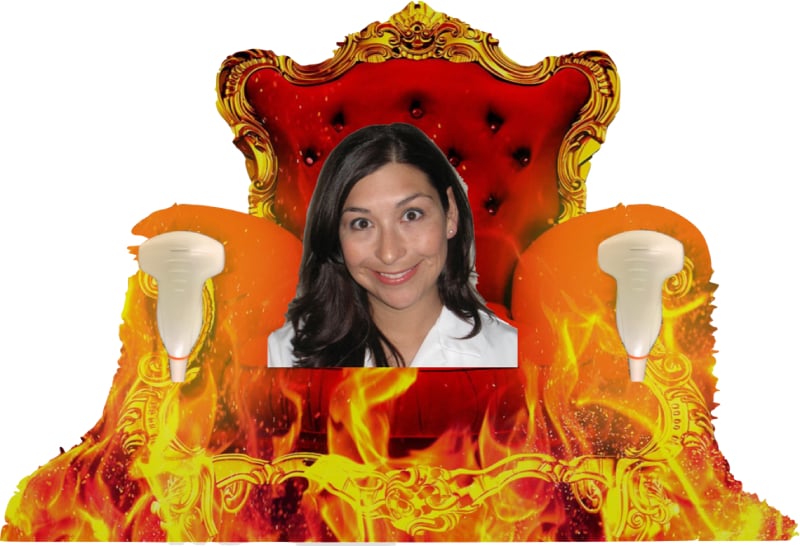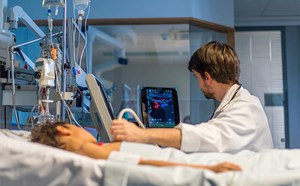
Sono Hot Seat with Petra Duran-Gehring on the ACEP Emergency Ultrasound Management Course
Petra Duran-Gehring, MD, FACEP
University of Florida College of Medicine – Jacksonville
Questions posed by Stephen Alerhand, MD
What ideas or events served as the impetus for developing ACEP's Emergency Ultrasound Management Course (EUMC) and how did you become involved?
The EUMC is usually held as a pre conference to the ACEP Scientific Assembly and originated from an ACEP section grant in 2003 to assist physicians tasked with the implementation and maintenance of ultrasound programs in the ED and was the brainchild of Dr. Vivek Tayal, who envisioned a way for US community members to share experiences in US program management and disseminate knowledge to new directors to continue to grow POCUS in EM. The initial 4-hour course in 2004 covered basic topics on starting and running an ultrasound program such as the importance of having an US program director, machine purchase and maintenance, credentialing, image storage and QA. In the last 20 years, the EUMC has expanded to a full-day course with 2 tracks of content, the Core content geared toward US fellows and new US directors as it contains all the essentials of program management, and Advanced content for those with US leadership experience. I took the original half-day course in 2007 as I was preparing to start my own ultrasound program at the University of Florida-Jacksonville and found the content super useful as a new ultrasound director and the information I learned helped to shape my program. So in 2013, I was asked to join the course as a speaker and leapt at the opportunity to share what I had learned after starting my own program and to add to the US management conversation. I joined the leadership team two years later as an Assistant Director and became the course Executive Director in 2019-2021. My goal has always been to share the wealth of knowledge within the US community and to encourage our participants to ask questions and learn from the struggles/battles/lessons of those who came before them, which is why I believe that the course remains so relevant.
What were some obstacles you faced in directing the EUMC? How did you address or respond to those?
I took over as the EUMC Executive Director in 2019 and in my first year I attempted to increase the interactivity of the course by breaking up the lecture format to allow participants more small group time to discuss their specific questions/issues with US leaders and I expanded the workshops to include topics such as ultrasound programs in community hospital EDs and incorporating social media/podcasts into US education with the plan to create multiple small group sessions for the 2020 course. Well of course, COVID ruined that plan as ACEP went to a virtual format for 2020. We usually begin planning the EUMC 10-12 months prior to the course, but in 2020 we had just a few months to switch from an in-person format to a virtual one, creating a stand alone course outside of the Scientific Assembly, which required us to think outside the box! As this was the start of the Zoom Video Conferencing era, I took a deep dive into Zoom to find ways to maintain the integrity of the EUMC and the two-track format. I utilized the Zoom poll feature instead of using Poll Everywhere, breakout rooms to create small group sessions, and asked speakers to record their lecture ahead of time in the event of internet outages, which allowed speakers to answer questions in the chat in real time while their lectures played. As we began to discuss the changes to the course needed for the virtual realm, everyone was asking the same questions: how is COVID affecting your ED and your US program? It became apparent that we really needed to address the elephant in the room which allowed us to pivot the course to a “Special COVID-19 Edition” to meet the needs of our community and the specific challenges that the COVID-19 pandemic created. We included new speakers with unique perspectives and experiences that could speak to how COVID was affecting US Programs, from machine cleaning recommendations to the effect on resident and fellow training. We were able to maintain the two track format while using breakout rooms to recreate the small group sessions and even concluded the day with a virtual cocktail reception to encourage networking between participants and speakers. Despite the virtual format, we had similar participant numbers as years prior and I learned a lot about virtual conference creation from that experience but am glad that we have returned to in-person events!
What have been the early successes or results of this course?
This course has helped many US directors get the tools to build a foundation for their ultrasound programs, a fact that I can personally attest to! The course continues this mission with fellows and new directors but also innovates each year based on the feedback from participants, such as the addition of a workshop for community ED programs, and new developments in the US community, such as the effects of the Milestone project on residency US training, Ultrasound Fellowship program accreditation and the initiation of the FPD examination. From the beginning, the course has tried to meet the needs of the US community and share knowledge between US leaders and those new to leadership positions, with an emphasis on the networking aspect of the meeting, which is especially important in today's virtual world. The course has consistently been full with many participants returning to the course to take the advanced track after completing the core track.
Where do you foresee the content and goals of the course moving forward?
We are always looking for feedback from our participants to shape the next iteration of the course, but I think that future topics will include guidance on TEE US program implementation and non-EM US program management. As we see more specialties outside of EM begin to develop US programs, we will see inclusion of topics and speakers that reflect the struggles inherent to those outside of EM- maybe a third track?!? This year we will include how the recent billing changes will affect US billing and the use of contrast enhanced ultrasound in the ED as one of our featured Pulse waves: Future EUS ideas gaining momentum segments. Planning for leadership succession is one of the organizational aspects of the course that has made it longitudinally successful, as each director brings new ideas to the tables so that the course continues to be relevant and useful to our community.
If you had to come up with a sales pitch (which you don't, because the course fills up annually) for someone to attend this course, what would it be? For a recently graduated fellow, non-fellowship graduate, etc.
Starting an EM Ultrasound program in a community ED? Looking to purchase new ultrasound machines but not sure where to start? Needing recommendations on ultrasound transducer cleaning? Wanting to create innovative ultrasound teaching?
Then look no further and join us for the ACEP Emergency Ultrasound Management Course to learn the elements needed to create and maintain an US program, start to finish while networking with US leaders from across the country. Bring your questions/issues to discuss in small group sessions with US leaders and work on your negotiation skills or learn the basic elements of podcasting for education in one of our interactive workshops. See what is up and coming in the world of US program management and be part of the conversation!
Be sure to join us for the post-course reception at Spin, a local ping-pong bar, for networking and cocktails, or challenge your favorite US leader to a game! We hope to see you there!
Register Today! https://www.acep.org/sa
https://www.acep.org/emultrasound/subcommittees/emergency-ultrasound-management-course-subcommittee
From teaching at larger educational events such as the EUMC, ACEP, SAEM, and SEMPA, what are your core tenets for curriculum or course design? Major pearls or pitfalls?
I think there are three initial questions to think about when planning a larger educational event: 1. Who is your audience? Medical students, residents, physicians, advanced practice providers, non-EM physicians? 2. What are the needs of the group? What do they want to learn? What are their goals? 3. What is the format of the education event? In-person, virtual, lecture only, hands-on session? Time frame of the session? These three components really shape what and how you can teach. Create clear objectives or goals as to what you will teach and ensure that the content will fit into the allotted time frame.
Pearls and Pitfalls:
- Planning is key! Do not wait until the last minute to find out the room layout or set up. Be proactive to ensure that you have seating/tables/set up to support the type of course you will have. That may mean downloading the room layout/map to be able to ensure that your course will maximize the space without compromising your objectives. Be sure to perform a walk-through of the space the day/evening before to ensure that everything is set up as you envisioned. Nothing is worse than having to abruptly pivot at the start of the course because you were unaware of the room set up!
- Know what supporting materials you have or will need to arrange. Large lecture courses need AV equipment not only for the speaker but you may also need power outlets for the participants if the course is more than a few hours. Will someone else be providing massage tables/gurneys for scan sessions or will you need to create “beds” for your models with hotel linens and tables? I bring some inexpensive self-inflating camping sleep mats to all my on-site courses to ensure that my models will be comfortable in the event that we have to make our own beds.
- Will the conference site provide a laptop or do you need to bring your own? How will your laptop connect for a presentation? I carry a bag with me with various connectors (USB, USB-C, HDMI, etc.) so that I am always prepared. I also always bring my own slide advancer/laser pointers as a backup.
- If you are teaching a hands-on event, be sure to have a clear understanding of who will be arranging models, phantoms and us machines/equipment. Will the models be paid or are they volunteers? Consider recruiting med students to volunteer as models. I often offer to stay after and scan with them as an added educational bonus. If you will be using phantoms, be sure to alot time and money if you are assembling them on site as well as storage and refrigeration (ie, meat or tofu models).
- Be sure to schedule enough faculty for hands-on courses with a max of 5 students: 1 faulty ratio to ensure that all participants get plenty of time to scan. Consider allowing faculty to prescan their models.
- Lastly, get organized! Ensure that all faculty are aware of the plan and on board with the objectives/course format/location/etc. I am a huge proponent of a shared spreadsheet and a group communication (text, whats app, etc.)



